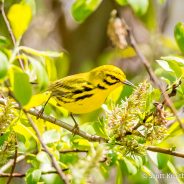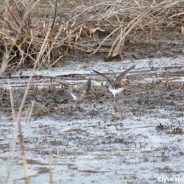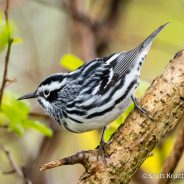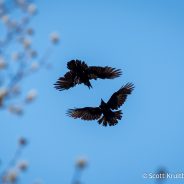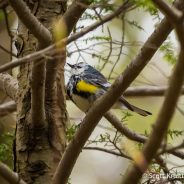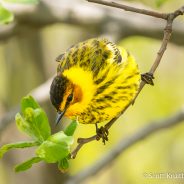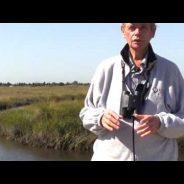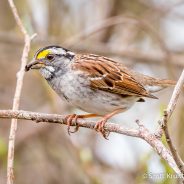I love this time of year. After the exuberance of summer and the vibrant colors of fall, I’m thankful for the days growing shorter. The nights longer. Temperatures falling. Silhouettes of bare branches against a leaden sky promising snow. All of nature winding down. Encouraging quiet. Reflection. Introspection. [more]
Salamander Saturday; a Slithering, Slimy Success!
Although the words slithering and slimy aren’t typically associated with good things, the opposite is true when you’re talking about celebrating all things salamander! Many thanks to all who joined us at RTPI to enjoy an array of displays and activities all centered on these fascinating and important creatures! Visitors enjoyed viewing a variety of live salamanders on exhibit by Chris Duckett of...
read morePrairie Warbler
This male Prairie Warbler (Setophaga discolor) put on a sensational display for us last Sunday all while singing away and finding plenty to eat after his journey the previous night. It took a few hours to finally see the bird after hearing the rising, buzzy song repeatedly in the morning. The sun was shining brightly high in the sky by the time he came out into the open, giving the yellow warbler an even brighter glow while foraging in these willows. The Prairie Warbler is one of those species that perplexes me in the Chautauqua-Allegheny...
read moreDynamic Habitats
I got a text the other day from my dad saying, “Hey if you can, bring your boots over so we can investigate the beaver pond.” Behind my parents home is a beautiful wetland system that sits right in the valley, with forested hillsides surrounding. What was once a stream has since been turned into a marsh thanks to the work of some busy beavers. With dams on either end of the marsh, the water has been held back and has created great habitat for many birds, amphibians and reptiles. The marsh is full of snapping and painted turtles,...
read moreNorthern Parula
Here we have the Northern Parula (Setophaga americana) as photographed while feeding this past Sunday morning after a busy night of migration. These little birds sound like zippers with a hard ending, or sometimes the “That’s all Folks!” song from Looney Tunes after several fast da and be notes. Those white eye crescents stand out from afar on a blue gray bird with a white belly featuring that bright yellow throat and upper chest with a reddish brown band. Northern Parulas are a gleaning species, snatching insects and...
read moreBlack-and-white Warbler
I finally took some good photos of Black-and-white Warblers (Mniotilta varia) over the last few days as the species is peaking as a migrant in the Northeast. These stunning little birds never stop moving…and they move like a nuthatch, creeping and crawling along branches, vines and tree trunks for various insects and spiders. This nonstop motion makes them a difficult clean capture as their photos often end up a little blurry. At least this guy – while still not paying me any attention – paused for a moment or two while...
read moreCommon Ravens
Common Ravens (Corvus corax) are known to be incredible fliers, soaring high in the sky and almost floating among the clouds, drifting and banking and turning and flipping with an endless array of aerial acrobatics. If you spend enough time hawk watching you will undoubtedly see them looking like a sizable raptor until fanning out that tail, showing off that bill and letting you hone in on that all black body. I watched these two Common Ravens interacting from afar as they dropped in altitude over a few minutes, croaking out their calls and...
read moreLeucistic Yellow-rumped Warbler
Here is that unique Yellow-rumped Warbler which I mentioned in a previous post. Can you see what looks different about it? I noticed it naked eye while tracking various subjects in a loose flock through the trees last week including more Yellow-rumps, Black-and-white Warblers, Blue-headed Vireos, and Blue-gray Gnatcatchers. After I got my binoculars on it I realized this bird was partially leucistic, and I quickly raised my camera to snap off a record photo. Leucism in birds is when melanin pigments are produced at less than normal levels or...
read moreCape May Warblers
Today I had the best views of Cape May Warblers ever during easily the best day of spring migration so far this year. Birds that had been trapped in the Mid-Atlantic for a week or 10 days finally moved north with heavy migration occurring on southerly winds. New England and northern New York had poor migratory conditions still, stopping a lot of birds when they arrived, and some areas of fog and/or rain also helped locally. I thought these couple of shots were the best I would get, and I was happy enough… But they decided to stick...
read moreNoble Proctor Video
NEXT SATURDAY: A celebration of Noble Proctor’s life in the form of a BioBlitz Challenge at Hammonasset Beach State Park in Madison, Connecticut on Saturday, May 14, 2016 from 8AM to sunset. Our headquarters for the BioBlitz will be at the pavilion near Willard’s Island. At 1:00 PM, we will come together as a group, sit down for lunch, and have a gathering at the pavilion to say a few words about Noble. Please take a look at this touching and wonderful short video on Noble by Patrick...
read moreWhite-throated Sparrow
I recently caught this White-throated Sparrow (Zonotrichia albicollis) in the middle of a meal… …which it seemed to try to hide from me until gulping it down. Their whites and yellows are much bolder right now than those that winter with us as they conclude their spring migration. In some cases you may have White-throated Sparrows year-round with some birds that overwinter at your house and head far north into Canada for the breeding season while other individuals move in to our area from even further south and nest relatively...
read more




